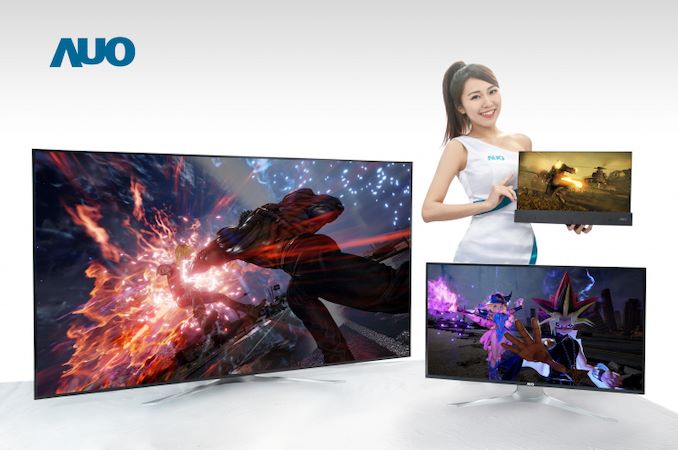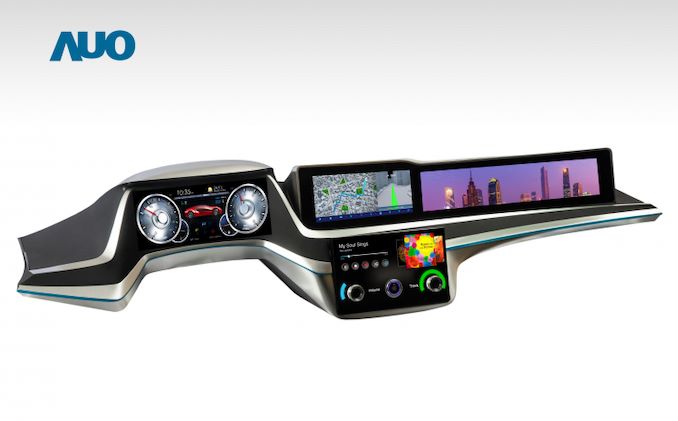AUO’s Mini LED Monitors: 32-Inch 4Kp144, 65-Inch 4Kp144, VR, & Others
by Anton Shilov on August 30, 2019 1:15 PM EST
Among other leading-edge consumer displays demonstrated by AU Optronics this week at Touch Taiwan 2019 trade show are the company’s monitors with Mini LED backlighting. The displays are intended for a variety of applications that benefit from high brightness and contrast ratios, including Ultra-HD televisions, computer displays, VR headsets, and in-car infotainment systems.
The largest Mini LED-enabled screen from AUO is a 65-Inch display featuring a 3840×2160 resolution, 2,500 nits peak brightness, a 144 Hz refresh rate, and over 1,000 local dimming zones. Officially, this one is called a ‘large size gaming display’ and could easily compete against NVIDIA’s BFGDs sold by ASUS and HP when it is available. Meanwhile, being a maker of panels, AUO cannot pre-announce actual retail products by its partners.
The somewhat smaller Mini LED offering from AUO is its 32-inch prototype featuring a 4K resolution, 1,500 nits peak brightness, a 144 Hz refresh rate, as well as over 1,000 local dimming zones. The LCD resembles ASUS’ 32-inch ProArt PA32UCX professional display introduced at CES, but has a considerably higher refresh rate and is positioned for gaming applications.
One more gaming screen from AUO featuring a Mini LED backlighting is a 17.3-inch LTPS 4K gaming display that meets VESA’s DisplayHDR 1000 (which means at least 1000 nits brightness) requirements and is designed for high-end notebooks.
Another interesting prototype with a Mini LED backlight module is AUO’s 2.9-inch LTPS display with 2,304 dimming zones as well as a whopping pixel density of 1,688 PPI. The screen promises ultimate fidelity and ultra-realistic VR experience, though it is unclear when AU Optronics will be able to ship the device commercially to interested parties.
Extending its Mini LED technology to non-gaming applications, AU Optronics has also developed a 12.3-inch LTPS curved cluster panel featuring a 750R curvature, a high resolution, 1000 nits brightness, and high contrasts. The screen is intended for vehicles, but considering how long it takes for auto industry to validate new technologies, AUO expects it to adopt this or similar displays within five years.
Based on the fact that AUO, which is one of the leading producers of LCDs on the planet, makes rather high bets on Mini LED-based backlighting, it looks like the technology certainly has a big future at least in high-end applications. What remains to be seen is when and whether this technology will get cheaper and will be used for mainstream displays.
Related Reading:
- AU Optronics's New 85-Inch 8K LCD TV with 1,024-Zone Backlighting
- ASUS Mini LED Professional Monitors Update: Available This Year
- Acer Joins Mini LED Monitor Club with Professional-Focused ConceptD CM7321K
- ASUS at CES 2019: ProArt PA32UCX 4K Monitor with 1000-Zone FALD Unveiled
Source: AUO












27 Comments
View All Comments
Lolimaster - Friday, August 30, 2019 - link
For minilef to be effective you need zones in the 10000s not just 1000zones.DanNeely - Friday, August 30, 2019 - link
The LED size, and AFAIK how they're made.Mini-LED has the potential to get mainstream displays to around ~1000 dimming zones.
Micro-LED are much smaller, approaching the size of pixels. For giant TVs they can serve as them directly similar to OLED; for conventional sized displays they're still too small but can push the number of dimming zones up massively. Innolux has a 32" 4k panel with 1,000,000 dimming zones under development; that corresponds to roughly 3x3 pixel dimming zones using microLEDs about 4.5x as large (area) as in Samsungs 75" 4k tv.
Guspaz - Friday, August 30, 2019 - link
Even with 1,000 local dimming zones, each LED still covers ~8,300 pixels, causing blooming artifacts on edges with large differences in brightness.LG's 2019 OLED TVs don't have this problem, and support 4K120 input and variable refresh rates (FreeSync) with reasonably low input lag (~7ms for 120Hz, ~14ms for 60Hz), though they're limited to 1440p120 for sources that don't explicitly support HDMI 2.1.
jeremyshaw - Friday, August 30, 2019 - link
I see you got suckered by the kool-aid, too. Freesync =/= HDMI VRR, so none of that for the 2019 LG OLEDs.Lolimaster - Friday, August 30, 2019 - link
I like Hisense approach using a 2nd black and white lcd layer.Thud2 - Friday, August 30, 2019 - link
IWhy do these [anels need local dimming? Is this an array of 2,000 LED's used as a backlight for an LCD panel?timecop1818 - Friday, August 30, 2019 - link
Yes, basically. The larger the panel, the harder it is to get uniform backlighting from edge-mounted led strips, so they figure if they fill the back of the LCD panel with a bunch of small leds and diffuse them, the backlighting becomes more uniform. And then they figured if all these leds are there, why not make them individually controllable to reduce actual light output when something with dark areas is shown on the screen. And this is how FALD (Full Array Local Dimming) came to life.Kvaern1 - Friday, August 30, 2019 - link
"Officially, this one is called a ‘large size gaming display’ and could easily compete against NVIDIA’s BFGDs sold by ASUS and HP when it is available."What does this mean ? NVIDIA doesn't make any screens that I'm aware of.
timecop1818 - Friday, August 30, 2019 - link
It means exactly that. ASUS and HP make 65" 4K screens. And NVidia links to them from their site: https://www.nvidia.com/en-us/geforce/products/big-...Kvaern1 - Saturday, August 31, 2019 - link
That doesn't make them "NVIDIA's" BFGD's. That just means they are advertised on NVIDIA's webpage because they come with GSync and Shield streaming technology (whatever that is).